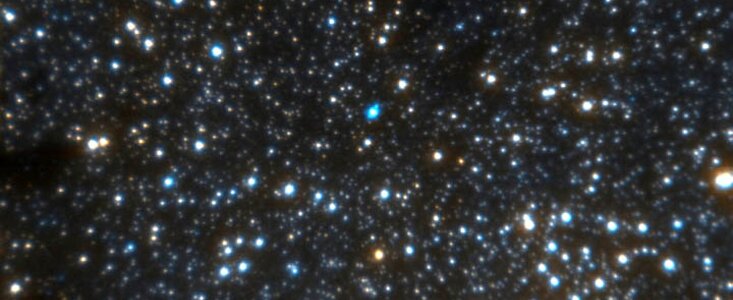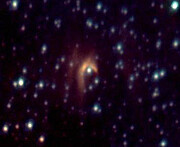IRS-8 - A unique bow shock in the Galactic Center region
6 Noviembre 2002
Perhaps flung from the Galactic Center's innermost cluster of hot stars some 20,000 years ago, the massive star IRS-8 is moving at supersonic speed through high density gas.
Located 8000 parsecs from the Sun in the direction of Sagittarius, the nucleus of the Milky Way is host to numerous high energy phenomena including a supermassive black hole of approximately three million solar masses which defines the dynamic center of our galaxy. The nucleus also contains a number of young clusters of recently formed hot and massive stars, peculiar radio-emitting filaments of ionized gas, supernova remnants, and a number of bright and compact objects whose natures and origins are unclear.
Because of the high dust content along the line of sight to the Galactic Center, it has been impossible to observe this region at ultraviolet and optical wavelengths. New tools such as infrared array detectors combined with adaptive optics on large 8-10 m telescopes have given astronomers new ways to explore this unique region of the nearby universe. For example, see the work published recently by Schödel et al. in Nature, Volume 419 October 17, 2002 pages 694-696.
Tom Geballe, Francois Rigaut and Jean-Rene Roy of the Gemini Observatory have analyzed the exquisite images obtained with the University of Hawaii's adaptive optics camera Hokupa'a-QUIRC on the Gemini North Telescope in order to study the unique object IRS-8, which is located 30 arcsec (= 1.2pc) north of the Galactic Center (geminiann02010a). This object has been known to be a strong infrared source for almost two decades, but the Hokupa'a infrared images (H and K') have revealed that the short wavelength IR emission from IRS-8 is largely in the form of a spectacular bow shock (geminiann02010b) surrounding a central star. The dust in the bow shock is heated and radiates because it is compressed by the shock and because it absorbs ultraviolet radiation from hot stars nearby, possibly including IRS-8's central star itself.
Interstellar bow shocks are produced when massive stars with envelopes or winds move at supersonic speeds (e.g. several tens or few hundreds km/sec) into the surrounding gas/dust of the interstellar medium. The stellar wind acts as a high pressure gas bubble surrounding the star. The bow shock is created at the interface where the force due to the kinematic push (ram pressure) of the moving (supersonic) stellar wind bubble equalizes the thermal pressure of the local interstellar gas into which the star is moving at high speed. The phenomenon is not unlike the bows created by ships or other crafts moving in water (except the water does not compress). With its apex at 0.01 pc (1000 AU) from the central star, the IRS-8 bow shock is a cosmic version of this phenomenon. Still, this stand-off distance is about 100 times smaller than all other known bow shocks due to stars speeding through interstellar space.
One reason for this compactness is the high density of the gas and dust into which IRS-8 is moving. Independent infrared and radio observations indicate that the density of the gas/dust is 100 to 1000 times higher than the average interstellar density in the Milky Way. IRS-8 may actually be colliding with the "northern arm", a region of high density molecular gas that has been mapped by infrared and radio astronomers. The arm seems to intersect the east side of IRS-8 bow shock, possibly explaining why this side of the bow is brighter than the west side.
The second reason for the bow shock's tightness is the high velocity of the star. If IRS-8's stellar wind properties are normal, the bow shock geometry and size require a space velocity of 150 km/s. Such a space velocity is unusually high for a young massive star far from the Galactic center, but is not unusual for objects within 1-2pc of the supermassive black hole. The axis of the bow shock gives the direction of the motion; IRS-8 appears to be moving to the northeast. It is also possible that IRS-8 was flung out of one the young clusters of stars, perhaps the central cluster located to its south about 20,000 years ago. The mechanisms known to be able to eject stars are either the explosion of one component of a binary massive system, or ejection from the cluster by multiple star interactions. In both cases, the space velocities acquired by the ejected stars can be as high as a few hundreds km/sec.
The study of objects like IRS-8 helps us to understand both the evolution of massive stars and clusters and the properties of the interstellar gas in the extreme environment of the Galactic center.
Geballe, Rigaut and Roy will present their results at the Galactic Center Workshop, held in Kona, November 2002.



